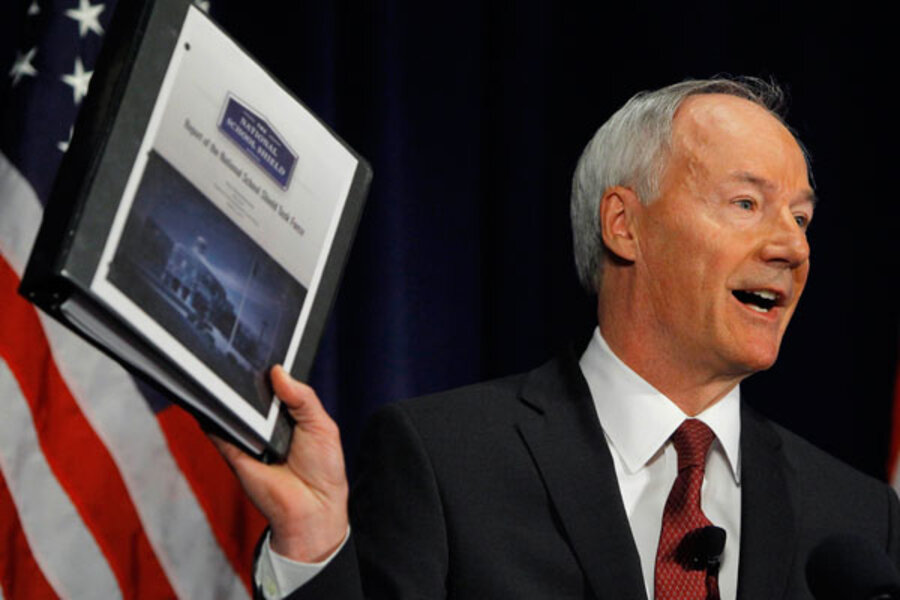Armed teachers? NRA task force suggests voluntary program.
Loading...
| Washington
A task force on school safety commissioned by the National Rifle Association raised the prospect Tuesday of arming school personnel – including teachers – after they have gone through comprehensive training.
Such a program would be voluntary, but could be crucial to halting an “active shooter” in a school and could save lives, said former Congressman Asa Hutchinson, director of the NRA's National School Shield Task Force.
“The key is reducing that response time,” said Mr. Hutchinson, speaking at a press conference at the National Press Club, where he unveiled a series of recommendations by the task force.
The “model training programs” the report recommends would be available to both “school resource officers” – police officers assigned to a school – and to school personnel, and would entail 40 to 60 hours of training.
The report’s release comes amid fierce debate on Capitol Hill over proposed federal gun legislation almost four months after the Newtown, Conn., elementary school massacre that jump-started national debate on firearms. President Obama heads to Colorado on Wednesday to call attention to new gun control measures enacted by that state, scene of two of the biggest mass shootings in US history.
Next Monday, the president goes to Connecticut for another event focused on guns.
The prospects for federal legislation remain uncertain, as gun-friendly legislators appear to have beaten back efforts to renew a ban on military-style assault weapons, such as the one used by the Newtown shooter. A proposed ban on high-capacity ammunition magazines is also on the ropes. Now, analysts say, gun control advocates’ best hope may be for expanded background checks for gun buyers. The legislation also includes money devoted to school safety.
Hutchinson largely avoided discussing the federal legislative battle, instead focusing on measures that schools can take now to assess security and make improvements. He also presented a more congenial pro-gun face to the public, compared with NRA executive vice president Wayne LaPierre’s memorable appearance before reporters soon after Newtown.
Then, Mr. LaPierre struck an aggressive posture toward the media, taking no questions, and offering no hint of compromise on any aspect of gun ownership.
“The only thing that stops a bad guy with a gun is a good guy with a gun,” he said.
Hutchinson, in contrast, was less absolute. On Tuesday, for example, he made clear that the task force was not recommending that all teachers be armed.
“Teachers should teach,” said Hutchinson, former administrator of the US Drug Enforcement Administration. “But if there is [one with] good experience, that has an interest in it and is willing to go through this training of, again, 40 to 60 hours that is totally comprehensive, then that is an appropriate resource that a school should be able to utilize.”
Hutchinson also made clear that while the task force recommends the presence of armed personnel in schools, each school district will decide what it wants to do.
“We want to make sure that our best practices and our resources are available to them, whatever decision that they make,” he said.
The report also recommends that the National School Shield become an umbrella organization on school safety, providing free access to a web-based assessment of a school’s security plan and to a database of best practices. The NRA has budgeted more than $1 million to aid school districts in their efforts to enhance security.
States would need to change laws to allow school personnel to carry firearms while they go through the model training program, he said. The report includes a model state law, and South Dakota recently passed such a law.
In Connecticut, home of the Newtown massacre, state legislation is moving in the opposition direction. On Wednesday, the state’s General Assembly will take up gun-control legislation that would expand the state’s ban on assault weapons, limit ammunition magazines to 10 rounds, and require background checks for all gun purchases, including those at gun shows.
Hutchinson called the Connecticut legislation “totally inadequate” as a measure aimed at enhancing school safety.
“You can address assault weapons and it doesn't stop someone bringing in a .45 caliber firearm into the school,” he said. “It doesn't stop violence in the schools. And so if you're going to protect children, you have to do something about school safety and enhancing our safety measures in school. It can be done, and that's the whole purpose of this task force.”
Hutchinson did not present a total cost figure for the task force’s proposals, noting for example that in one jurisdiction an armed guard might cost $60,000 to $90,000, while in California, the cost tops $100,000. Another member of the task force said that the cost of providing the 40 to 60 hours of firearms training to school resource officers and school personnel would cost between $800 and $1,000.
The task force did not address the specifics of how many armed personnel would be required to secure a school, based on the configuration of a school building or buildings, or the number of students. Doors are also important – how many there are, how they lock. Recess and other times when students might be outside present another vulnerability. On all of the above, each school district would have to make its own determination, Hutchinson said.
“Obviously, an SRO [school resource officer] in every school building is important,” he said. “But right now you have SROs rotating maybe between three campuses. I would judge that insufficient.”
The Democratic chair of the House Gun Violence Prevention Task Force took issue with the NRA task force proposal. Rep. Mike Thompson (D) of California, a hunter and gun owner, called school safety efforts important, but added that "arming school personnel and training them for shootouts will only exacerbate problems."








